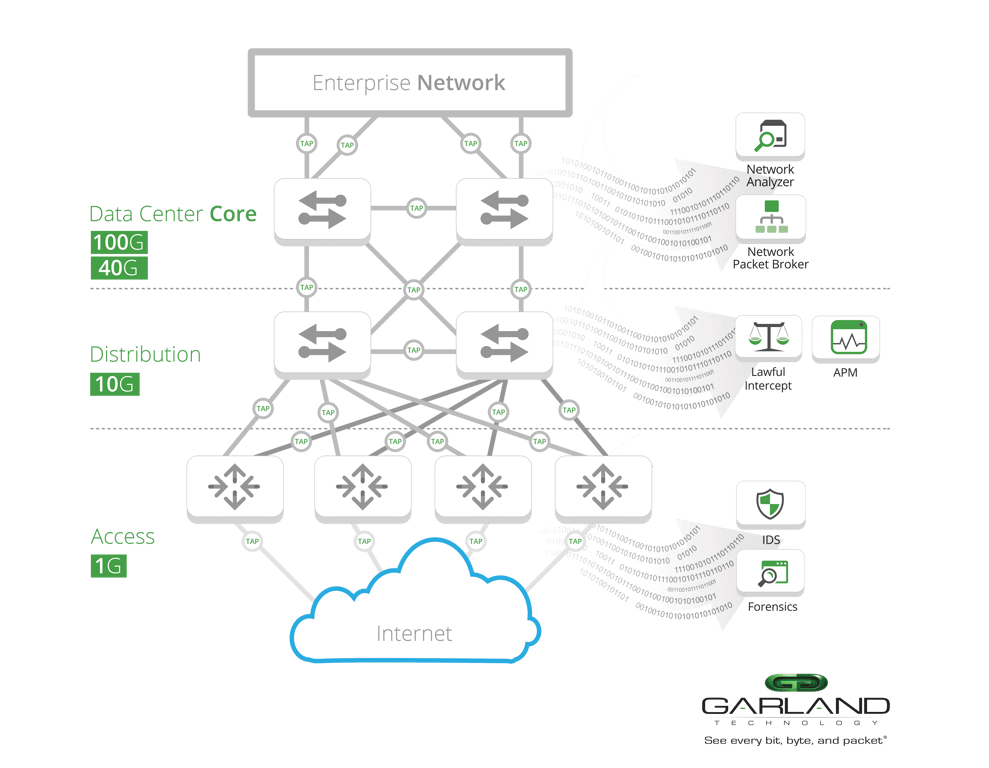Garland Technology Expands Passive Network TAP Product Line to 100G for Data Center and Mobile Networks
January 21, 2016

Buffalo, NY—Garland Technology, today announced an expansion of their passive network TAP products to meet the increasing demands of expanding data centers. With exponential growth in bandwidth and traffic, the demand for high-bandwidth monitoring infrastructure from 10G links now extends to 40G and 100G.
Highly Scalable 40G and 100G Network Visibility Solutions
Garland Technology has partnered with several major technology leaders including Cisco, Big Switch Networks and Accolade Technology in the development of 40G and 100G visibility and access solutions. All of Garland network TAP solutions are made, tested and certified in the USA.
“As our partners’ bandwidth demands grow in the areas of monitoring and securing network traffic, we needed to provide a reliable visibility solution. Our network TAPs have been tested and validated by these leading technology companies to ensure that all the data - every bit, byte, and packet® - feeds their monitoring or security solution.” said Chris Bihary, CEO/Co-Founder of Garland Technology. “We are committed to providing solutions for the complete enterprise network, from 1G access to 10G distribution and up to 40G and now 100G data center core.”
“We are partnering with Garland to deliver next generation 10G, 40G, and now 100G network packet brokers for high-performance data center visibility and security,” said Prashant Gandhi, Vice President of Products and Strategy at Big Switch Networks.
Big Switch Networks is the leader in next generation scalable network packet brokers. Garland and Big Switch Networks recently partnered on a joint webinar to discuss how Garland’s network TAPs are deployed with Big Switch’s Big Monitoring Fabric to provide a 10G/40G/100G monitoring solution that is simple, scalable and cost-effective.
The recent product additions include:
40G-SR4 and 100G-SR10 MTP® Passive Fiber Network TAPs. Features include:
- MTP® brand connectors for lowest dB loss per connector.
- New Prism based technology that reduces bit errors on OM3 + OM4 applications, providing 100% utilization.
- Available in 40G-SR4 or 100G-SR10 Multi-Mode.
40G and 100G Single-Mode Passive Fiber Network TAPs. Features include:
- No upgrade needed. This handles today and tomorrow’s network traffic.
- Supports long range and extended range single-mode environments.
- Scalable design with 1U rack mount kit that holds up to 4 modules, each module can have 1, 2, 3 or 4 TAPs.
40G-SR BiDirectional TAP to support Cisco’s BiDirectional Optical Technology. Features of this new product line include:
- Exclusive High Density solution with 21 TAPs.
- New Prism based technology that reduces bit errors on OM3 +OM4 applications.
- Scalable design with 1U rack mount kit that holds up to 4 modules, each module can have 1, 2, or 3 TAPs.
- Garland will showcase this product at the upcoming Cisco Live Berlin Expo, February 15-19, 2016.
Accolade Technology is the technology leader in high performance packet capture and application acceleration adapters/NICs. Garland Technology and Accolade Technology began a technology partnership in June 2015 through collaborative testing, measurement and validation of Garland’s 10G, 40G and 100G passive fiber network TAPs with Accolade’s ANIC adapters which are widely deployed within global OEM tier 1 network monitoring, security and OEM customer appliances.
“We have rigorously tested our products against Garland Technology’s comprehensive line of 10G, 40G and 100G passive fiber network TAPs and are pleased to announce our technology partnership.” said Robbie Dhillon, CEO of Accolade Technology. “Garland’s TAPs exceeded the demanding benchmarks and high performance requirements of our mission critical testing protocol.”
“The collaboration with our technology partners to is a prime example of how the network visibility community works together on joint solutions to ensure 100% packet capture in network monitoring and analysis appliances.” said Bihary.
Network TAPs are considered the best practice by network professionals when 100% packet capture and traffic visibility is required. Companies that still rely on their traditional SPAN port will eventually experience lost packets from oversubscribed ports, thus making their network monitoring and analysis appliances ineffective.
About Garland Technology
Garland Technology guarantees precise data monitoring capabilities with a full line of access products: network TAPs that support aggregation, regeneration, bypass and breakout modes; packet brokering products; and cables and pluggables. Garland Technology manufactures, tests and certifies all of its products in the USA.

